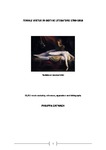Female Virtue In Gothic Literature 1780-1810
| dc.contributor.supervisor | Gray, Kathryn | |
| dc.contributor.author | Catnach, Philippa | |
| dc.contributor.other | Faculty of Arts, Humanities and Business | en_US |
| dc.date.accessioned | 2016-08-12T10:33:30Z | |
| dc.date.available | 2016-08-12T10:33:30Z | |
| dc.date.issued | 2016 | |
| dc.identifier | 10473132 | en_US |
| dc.identifier.uri | http://hdl.handle.net/10026.1/5285 | |
| dc.description.abstract |
My thesis analyses presentations of the concept of female virtue in Gothic literature between 1780 and 1810 particularly by drawing on literary texts supplemented by contemporary non-literary sources in order to set out the background and definitions of my work. The word ‘virtue’ has come to mean ‘goodness’ or ‘morality’ but looking at eighteenth-century usage it has often been gendered female and nearly always had a sexual quality: female morality was irrevocably intertwined with a sexual code of conduct. Daughters (perhaps most famously in the mid eighteenth-century Pamela in Richardson’s popular 1740 novel of the same name) were reminded that their most important attribute was intact virginity and wives were constantly retold that their worth relied upon their chastity and therefore their ability to bear legitimate children. While these ideologies were enduring throughout the entirety of the long eighteenth century, they could almost be considered requisite to the myriad of Gothic works published particularly during the disorder of the French Revolution. Due to the political and social uncertainty of the times the Gothic novelists felt called upon to either seek to protect patriarchal values or use the upheaval to abandon traditionally restraining concepts of female virtue. My first chapter (‘Virtue Explored: The Concept of Virtue in Ann Radcliffe’s The Italian’) introduces how the idea of virtue was defined and propagated in the eighteenth century – particularly by looking at contemporary conduct books – and whether or not Radcliffe embraces or rejects these conservative ideals of female sexual virtue. I examine Radcliffe’s development of female virtue away from a wholly sexual construct towards a more progressive and nuanced model. My second chapter (‘Virtue Transgressed: Sexual Transgression in Matthew Lewis’s The Monk’) builds on the first by taking the concepts of virtue I looked at with Radcliffe and exploring how the frequent Gothic theme of rape or sexual transgression plays into ideas of female virtue. My research seeks to highlight that Lewis uses the sexual transgression of his female characters (with the rape of Antonia and the pre-marital sexual relationship between Agnes and Raymond) to shock the reader with unabashed portrayals of controversial material but does predominantly define female virtue within traditional boundaries. The final chapter of my thesis (‘Virtue Abandoned: Desire in the Fiction of Mary Wollstonecraft and Charlotte Dacre’) looks at revolutionary fiction by two controversial female writers and how they present a breaking away from traditional sexual purity concepts. By examining a sample cross-section of Gothic literature between 1780 and 1810 I aim to answer how far the works were transgressive of traditional values and sexual politics or whether they were, in actuality, complicit in further promulgating conservative, patriarchal female virtue concepts. I argue that although to a modern reader the Gothic novels here researched may not seem overtly ‘feminist’, they are – in their re-modelling of female virtue, their unconventionally free but scandalous representations of female sexual transgression, and their abandonment of conformist female sexual codes – innovative and often defy the tide of conservative literature largely circulated at the time. | en_US |
| dc.language.iso | en | en_US |
| dc.publisher | Plymouth University | en_US |
| dc.subject | Female Virtue | en_US |
| dc.subject | Eighteenth Century | en_US |
| dc.subject | Gothic | en_US |
| dc.subject | Gothicism | en_US |
| dc.subject | Chastity | en_US |
| dc.subject | Ann Radcliffe | en_US |
| dc.subject | Matthew Lewis | en_US |
| dc.subject | Mary Wollstonecraft | en_US |
| dc.subject | Charlotte Dacre | en_US |
| dc.subject | Transgressive fiction | en_US |
| dc.title | Female Virtue In Gothic Literature 1780-1810 | en_US |
| dc.type | Masters | en_US |
| plymouth.version | Full version | en_US |
Files in this item
This item appears in the following Collection(s)
-
01 Research Theses Main Collection
Research Theses Main


